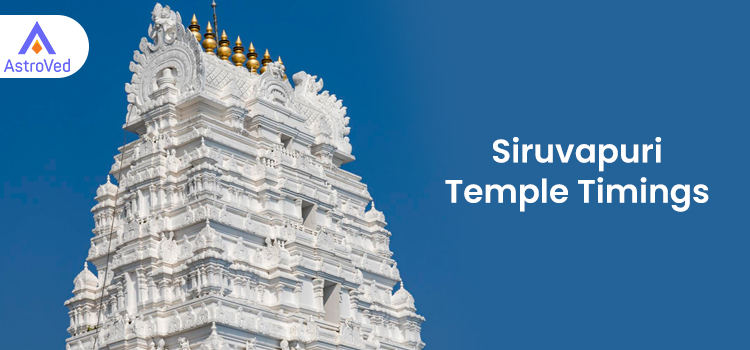Siruvapuri temple is dedicated to Lord Murugan, the son of Lord Shiva and Goddess Parvati. The temple is 40 km from Chennai in Tamil Nadu, 3 km off the Chennai-Kolkata highway. A unique feature of Siruvapuri temple is the Maragatha Mayil (emerald-colored peacock). The peacock is Muruga’s mount, and the one here is made of green stone. It is believed that the temple was built by the Vijayanagar rulers during the 13th century.
People who visit this temple are not required to observe strict vows like fasting. They need not come here in person, too. The belief is that the mere act of thinking about Siruvapuri Murugan can fulfill one’s desires. Once their wish is granted, devotees perform Milk Abishekam to the deity to express their gratitude. Devotees believe that having darshan at this temple on 6 consecutive Tuesdays can grant their wishes.
Legend of the Temple
Legend says that Lord Rama’s twin sons, Lava and Kusa, dwelt in this place. When Rama performed the Ashwamedha Yagna, the Yagna horse wandered into this area, and Lava and Kusa captured it. When Rama’s army came in search of the horse, the boys refused to give up the horse and fought the army of Rama, as they did not know that Rama was their father. Hence, the place got the name ‘Siruvar Por Puri’. In Tamil, ‘Siruvar’ denotes children, while ‘Por Puri’ means ‘to wage war’. The place is now called Chinnambedu, which is a corruption of the phrase ‘Siruvar Ambu Edu’ meaning ‘children who took their arrows’.
According to another legend, a lady called Murugammai lived in this village many years ago. She was a very ardent devotee of Muruga here. However, her constant prayers and worship of Murugan irritated her husband, who told her to stop it. But she did not heed him. One day, her husband cut off her arms in anger. Murugammai cried to Muruga for help. Pleased with her devotion, Muruga supposedly healed her hands without even leaving any scars.
Muruga here is known as Balasubramanyar. He is a powerful deity who grants the wishes of his devotees. One can also worship Annamalaiyar (Shiva) and Unnamulai Amman (Parvati). The utsava moorthy of Muruga is Valli Manalar, where he is in a wedding posture with his consort Valli. People believe that Muruga here will fulfill the wishes of those who seek to own a house. Hence, many visit this temple and pray to the deity here to realize their wish.
Murugan has many names; one is ‘Valli Kanavan’ or ‘Vallinayakam’, meaning ‘husband of Valli. Murugan has two wives – Valli and Deivanai. The latter is the daughter of Lord Indra, while Valli is a tribal girl and a human. Murugan’s Vallinayakam form has a deep philosophical significance. It denotes that all are equal before God.
In this temple, Valli shines as Ichhā Śakti. The marriage of Murugan and Valli has been described by Tamil scholars as an example of ‘kalavu manam’ or ‘furtive love’. The image which depicts him in wedlock with Valli is Valli Kalyāna Sundarar. As per the Kumāra Tantra, this form has one face and four hands. The two hands in front display Abhaya mudrā, and the other displays the Kadyavalmpītham posture (hand placed on the hip). His two rear hands hold a Rudraksha māla and Kamandalu. The idol is around 4.5 ft tall. On the right side is a resplendent Valli. Murugan holding Valli’s hand in preparation for wedlock is the only one of its kind. People worship this form of Murugan to overcome delays and obstacles in marriage.
In this temple, one can see the idol of saint-poet Arunagirinathar near the sanctum facing the deity. He is said to have visited this temple on several occasions and sung many Thiruppugazh songs. He also composed an Archanai Thiruppugazh on Muruga, which can supposedly grant one’s wishes when recited. Thiruppugazh, which was composed during the 15th century, means ‘divine glory’. It is one of the most major religious works of the medieval era of Tamil literature and is praised for its musical and poetical attributes as well as its moral, philosophical, and religious content.
Other deities here include Maragatha Vinayakar, Aadhi Murugar, Naagar, Venkatrayar, Bhairavar, and Muniswarar.
Temple Festivals
The main festival here is Panguni Uthiram, held in Panguni month (March- April), which attracts lakhs of devotees. The highlight of the festival is a grand procession of the presiding deities. Other major festivals at the temple include Shasti, Vaikasi Vishakam, Diwali, Soora Samharam, Karthigai Deepam, Tamil New Year, Thai Pongal, Saraswati Pooja, Thai Poosam, Mahashivaratri, etc.
Temple Architecture
The temple architecture is a syncretic mix of Dravidian and North Indian styles. The main Gopuram is quite tall, at 108 feet, and has intricate carvings of various deities. The temple tank, called Saravana Poigai, supposedly has healing powers.
Temple Timings
Morning: 7. 00 am to 12.00 noon
Evening: 4:30 pm to 8.00 pm.
On Tuesdays, the temple is open all day.
How to Reach
By Air:
The nearest airport is Chennai International Airport, 50 km away.
By Rail:
The nearest railway station is Ponneri, around 9 km away, or Gummidipoondi, around 10 km away.


